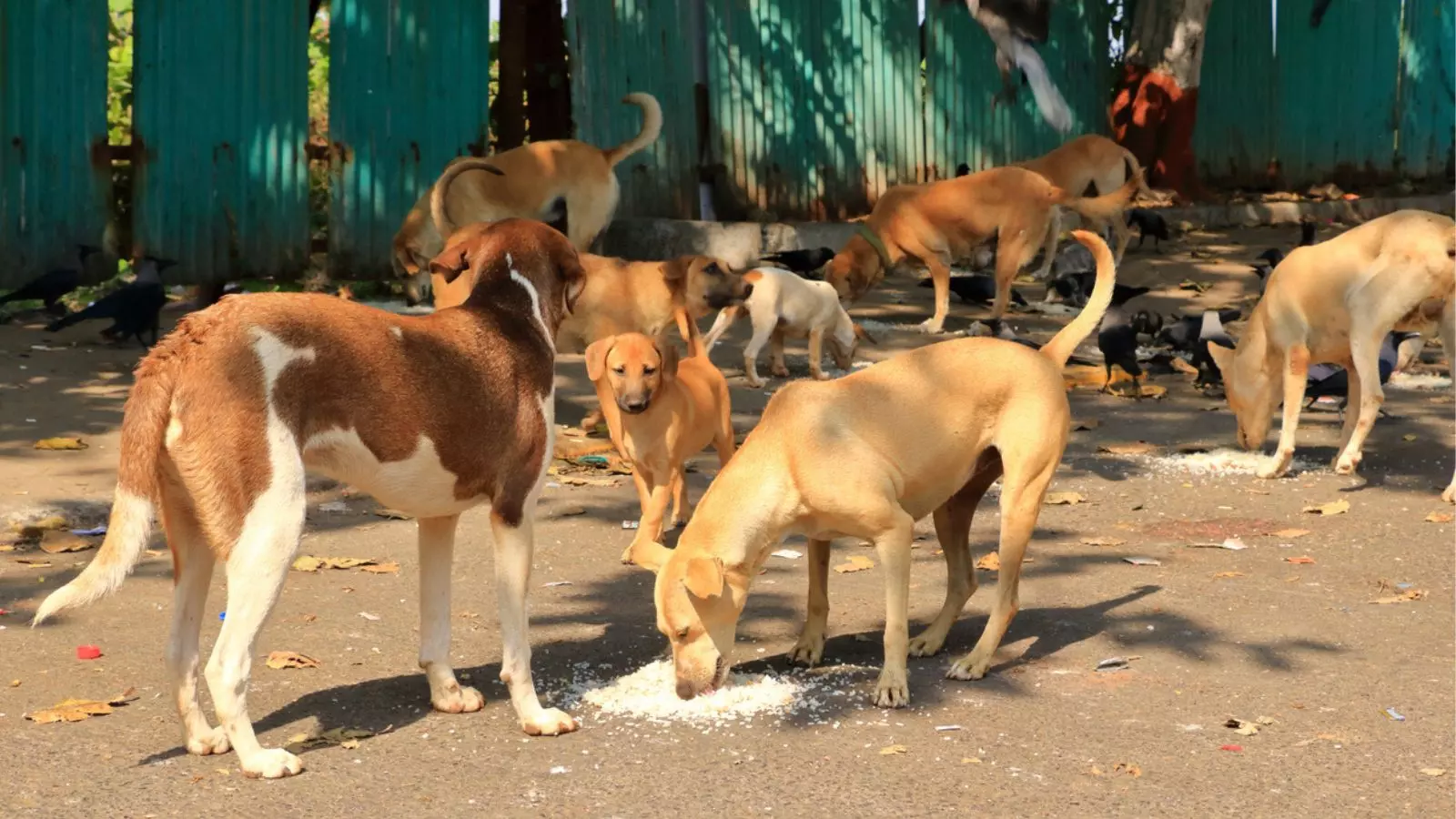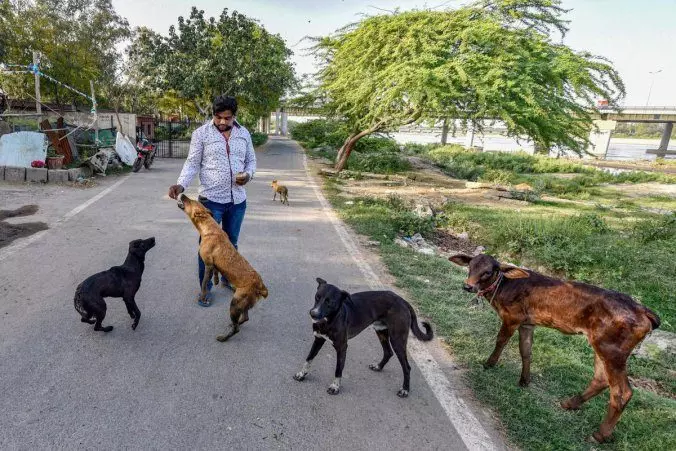
- Home
- India
- World
- Premium
- THE FEDERAL SPECIAL
- Analysis
- States
- Perspective
- Videos
- Sports
- Education
- Entertainment
- Elections
- Features
- Health
- Business
- Series
- In memoriam: Sheikh Mujibur Rahman
- Bishnoi's Men
- NEET TANGLE
- Economy Series
- Earth Day
- Kashmir’s Frozen Turbulence
- India@75
- The legend of Ramjanmabhoomi
- Liberalisation@30
- How to tame a dragon
- Celebrating biodiversity
- Farm Matters
- 50 days of solitude
- Bringing Migrants Home
- Budget 2020
- Jharkhand Votes
- The Federal Investigates
- The Federal Impact
- Vanishing Sand
- Gandhi @ 150
- Andhra Today
- Field report
- Operation Gulmarg
- Pandemic @1 Mn in India
- The Federal Year-End
- The Zero Year
- Science
- Brand studio
- Newsletter
- Elections 2024
- Events
How West Bengal is teaching kids compassion for strays, ways to avoid dog bite
School education programme in West Bengal has incorporated safety advisories on interacting with stray dogs in curriculum and urged schools to feed the animals with mid-day meal leftovers

Ajay Bar, a driver based in Kolkata, carries a stick with him whenever he has to be out on work after 7pm. Most of Bar’s employers — he works on freelance basis — are residents of housing complexes in the city’s Haridevpur police station area, which he claimed was notorious for its large population of often-ferocious stray dogs.One man’s best friend is another’s terror! Bar pointed...
Ajay Bar, a driver based in Kolkata, carries a stick with him whenever he has to be out on work after 7pm. Most of Bar’s employers — he works on freelance basis — are residents of housing complexes in the city’s Haridevpur police station area, which he claimed was notorious for its large population of often-ferocious stray dogs.
One man’s best friend is another’s terror! Bar pointed to a scar on his left ankle, incurred, he added, from a dog bite five years ago; he had been attacked by some strays while returning home from work one night. Ever since, he said, he has carried the stick to defend himself in case there is a repeat of that horror.
Of late though, Bar conceded, there has been a change in the animals’ behaviour. No longer are they the aggressive canines who would hound him at sight.
“Earlier, whenever I cycled past them, even though I was a regular visitor to the area and therefore familiar to them, they would come chasing me in a group. Now, however, they seem almost indifferent,” he explained. The change, he believes, started sometime in the winter of 2024, or perhaps a few months before that.
Also read: Karnataka SC quota: Why nomadic communities feel let down by Siddaramaiah govt
What might surprise him to know, however, was that the calm that he has been noticing in the dogs was brought about not by the use of fear, threat, or violence, but through a show of love and compassion. “One of the most effective ways to calm stray dogs is through feeding as regular meals help reduce survival-linked anxiety,” explained animal rights activist and physician Dr Prabhakar Mandal. And that is exactly what a few animal lovers in the area, including Mandal, have been doing.

Representational image of stray dogs. iStock photo
While community acceptance of indie breeds — including feeding and adoption of strays — has been a growing trend over the past years, what animal lovers across India would find inspiring are a slew of measures the West Bengal government has been initiating since last year to inculcate the culture of peaceful coexistence with animals among the young. Government and government-aided schools across the state have been advised to use mid-day meal leftovers to feed strays in their areas.
West Bengal started the year with fewer dog-bite cases than many other states, according to the latest figures (for the month of January) shared by the Union ministry of fisheries, animal husbandry and dairying. The state reported only 10,264 dog bite cases that month, significantly lower than the figures reported by states like Uttar Pradesh (20,478), Tamil Nadu (48,931), Rajasthan (15,062), Odisha (24,478), Telangana (10,424), Maharashtra (56,538), Kerala (11,649), Karnataka (39,437), Gujarat (53,942), Bihar (34,442), Assam (20,900), and Andhra Pradesh (23,180).
According to West Bengal’s minister of animal resources development (ARD), Swapan Debnath, the following months (since January) have, prima facie, seen a further dip in incidents of dog bites and state officials are hopeful that West Bengal would end the year with a significant drop in such cases from the previous year’s 76,486.
Also read: How overcrowded shelters and MCD negligence left Delhi’s stray dogs in limbo
The encouraging trend in West Bengal comes at a time when the issues of dog bites and treatment of strays have become hotly-debated subjects across the country. In August, the Supreme Court directed NCR authorities to relocate street dogs to shelters and not to release them back into public spaces. Days later, it modified the order to allow the release of sterilised and vaccinated dogs, except those with rabies or signs of aggression. It, however, restricted the feeding of strays on streets, directing authorities to create designated feeding areas for the dogs. The top court also asked states and union territories to facilitate the framing of a uniform policy on strays.
In such a scenario, Mandal felt, what West Bengal is witnessing could, if sustained, redefine the human-dog relationship in the state.
While Debnath said his department had intensified sterilisation drives for stray dogs since last year, to strengthen birth control efforts and help curb dog bite cases, according to data shared by the Kolkata Municipal Corporation (KMC) with the high court last month, the drive — particularly in Kolkata — appeared to be largely driven by non-governmental organisations. The numbers showed the KMC falling way short of its targeted sterilisation of 15,000 to 20,000 dogs annually and currently neutering a mere 10 to 15 dogs daily.
Animal rights activists also attributed the likely positive trend with respect to dog bite cases in the state to individual and community initiatives, such as the one by Mandal and his fellow dog lovers in Haridevpur.
"Neutering and adoption are mostly carried out by non-governmental organisations, with pet lovers also stepping in independently," claimed activist Roma Chakrabarty, who runs the pet-care facility, Valobasha, on the northern outskirts of Kolkata. According to her, Valobasha, facilitates the sterilisation of 10 to 12 stray dogs every week. Each procedure costs a minimum of Rs 3,000 to Rs 3,500 at a non-government facility, said veterinary physician Anirban Roy. Most NGOs, including Valobasha, do not receive any government support for their efforts, Chakrabarty claimed.

File photo of strays being fed. PTI image
The animal rights activist, however, commended the West Bengal government’s efforts to integrate the issue of stray welfare into the state’s educational system.
Last year, the Paschim Banga Samagra Shiksha Mission (PBSSM), the state’s school education programme covering pre-school to class 12, incorporated safety advisories on interacting with stray dogs in the curriculum. As part of its directives to district education officers, the PBSSM recommended that schools promote a safer environment for students in areas where stray dogs are present.
Also read: How West Bengal is pushing back against BJP’s Bangladeshi infiltration narrative
One key focus was educating children on how to behave responsibly around these animals. Schools were encouraged to use morning assemblies to spread awareness, teaching students to avoid approaching groups of stray dogs and to never provoke the animals by shouting, hitting, or throwing objects at them. Instead, students were advised to stay still and composed if a stray dog was nearby, to avoid staring directly at it and to seek help from nearby adults if the animal showed signs of aggression.
Another PBSSM advisory, urging government and government‑aided schools to feed stray dogs using midday meal leftovers, was issued in June this year. The aim was to inculcate the values of kindness and responsibility in students. Teachers and mid-day meal workers were directed to oversee the feeding process, while students were encouraged to assist them. The advisory was part of a broader initiative believed to be aimed at teaching children compassion toward animals in their communities.
Schools were also urged to coordinate with the district ARD department to facilitate vaccination and sterilisation of stray dogs. “The broader goal is to not just reduce dog bites, but to instil a lifelong understanding of coexistence [in students],” explained Animesh Halder, South 24-Parganas district secretary of the Secondary Teachers and Employees Association.
The initiatives have already helped bring about a shift in students’ behaviour.
"Earlier I used to think stray dogs were dangerous, but after learning about them in school and helping with their feeding, I’ve started to feel sorry for them," said Joy Mandal, a Class 8 student of Manmathapur High School in Kachukhali, South 24 Parganas. "Now, I even recognise some of the dogs. They come near the gate around lunchtime and sit there. I sometimes feed them, since I’m not as scared anymore," he said.
While neutered and vaccinated dogs were less likely to fight, roam in groups, or display aggressive behaviour, said Chakrabarty, their integration into the community through adoption or regular feeding would further help reduce chances of conflict.
“What we’re seeing now is just the first glimmer of change,” Mandal cautioned, “and it needs to be sustained through continuous efforts by the community and the government. That will be the true test.”
